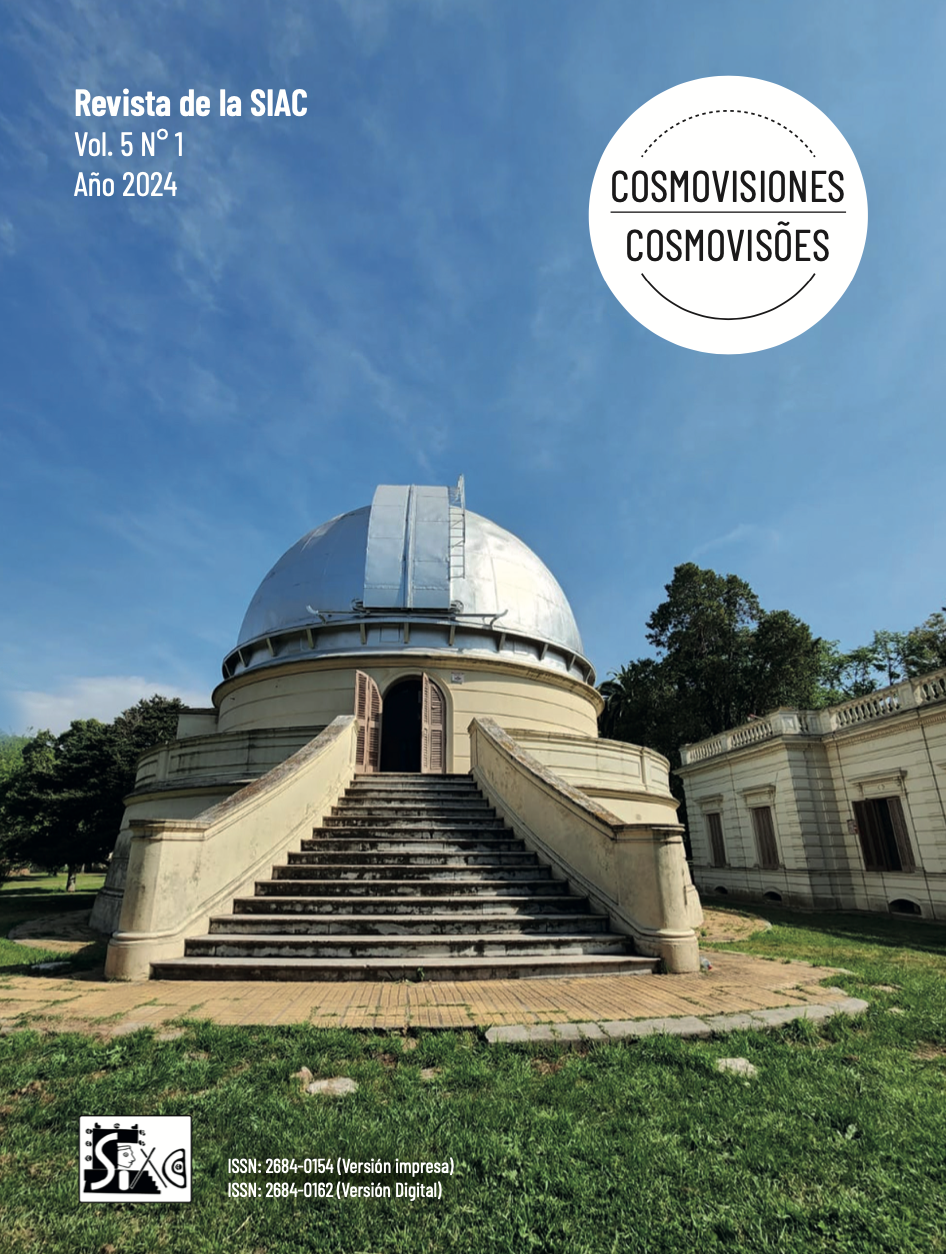Full moon extreme positions, lunar standstills and the metonic cycle at Cañada de la Virgen archaeological site
DOI:
https://doi.org/10.24215/26840162e009Keywords:
artificial landscape calendar, major and minor lunar standstlills, full moon extreme positions, Venus extreme positions, mesoamerican day count intervalsAbstract
The purpose of this work is to show the extreme positions of the full moons of June, seen from the main entrance into the enclosed patio of Complex A at the archaeological site Cañada de la Virgen. These positions are discussed in terms of the cycles known as major and minor lunar standstills, as well as the metonic cycle.
Given the publication guidelines, an enormous effort of synthesis had to be made when dealing with the high number of astronomical events and dates that have been worked through the Permanent Program of Celestial Observations at Cañada de la Virgen. For the same reason, I had to limit possible comparative examples that would serve to justify the dates or “date families” detected in the site, with others studied in Mesoamerica.
Nevertheless, the architectural, calendrical and symbolic implications of the pre-Hispanic cosmovision are revealed, as well as the intricate autochthonous astronomical features of the specific cultural region of El Bajío. On the other hand, although there are other examples that deal with the functionality of pyramidal structures acting as a hill or artificial horizon, only Rubén Morante (1996) is cited, since he coined such term while working at Teotihuacán in central México.
The different lunar positions shown are intertwined with the rhythm of the sunset, emphasizing the moments when such celestial object rests on the different superimposed bodies of the pyramidal base. Particularly in the corners and slopes where these bodies intersect, creating numerical intervals that have certain qualities of multiplicity with recognizable Mesoamerican calendar units: 20, 13, 5, 52, 65, and so on. Actually, 65 is the interval that became evident as the exercise unfolded. The number appears in terms of years and tens of years, within cycles that could -eventually- be associated with the founding moment of the ceremonial center that concerns us, considering the dates of Carbon recovered by Gabriela Zepeda (2012). As coordinator of the exploration of Cañada de la Virgen, Zepeda emphasized the role of cultural astronomy as a complementary method to explain the foundational dates, along with the moments revealed as differentiated stages of occupation through construction system features1.
The internal congruence of the presented model explains the importance of the major and minor lunar positions and discusses the appropriate terminology in terms of references to lunar standstills, lunistices or maximum and minimum extremes of full moon.
1 Personal conversation with archaeologist Gabriela Zepeda. Susan Milbrath discussed the stages of occupation of Templo Mayor in terms of the 52 years of the new fire.
Downloads
References
Aveni, A. (2001) Sky Watchers, a revised version and Updated Version of Skywatchers of Ancient Mexico, Texas: University of Texas Press.
Cárdenas, E.(2017) Interacción regional por medio de la arquitectura prehispánica en la tradición Bajío. In: Cárdenas, E. (ed.) Mirgaciones e Interacciónes en el Septentrion Mesoamericano. México: El Colegio de Michoacan: 151-168.
Dolet, Simon (2020) L’astrologie saine de Giuseppe Toaldo. Un astro-météorologue dans la République des sciences, Mémoire de M2 recherches Civilisations, Cultures et Sociétés, Centre de la Méditerranée Moderne et Contemporaine, Nice, France.
Esparza, R., Jiménez Reyes, M. y Tenorio, D. (2017) Los caminos de la obsidiana en el Occidente de México.In: Cárdenas, E. (ed.) Mirgaciones e Interacciónes en el Septentrion Mesoamericano. México: El Colegio de Michoacan: 275-296.
Fisher, D.& Sims, L. (2017). Modelling Lunar Extremes. Journal of Skyscape Archaeology. 3. 207-216.
Galindo, J, (2002) Cocijo: deidad definitoria de una alineación calendárico astronómica. La pintura mural prehispánica en México, Boletín Informativo, diciembre 2002 VIII(17). México: Instituto de Investigaciones Estéticas, UNAM.
Martz de la Vega, H., H. Patiño Rodríguez Malpica, R. Ángeles Meléndez e I. A. Jaimes Hernández (2021), Arqueoastronomía y calendario de Tula Grande, In: La vida bajo el cielo Estrellado S. Iwaniszewski, R. Moyano Vasconcellos M. Gilewski (eds.), Editorial de la Universidad de Varsovia, Varsovia: 115-126.
Migeon, G. (2013) Excavaciones de dos áreas residenciales de dos sitios, tipo-cronología de la cerámica y secuencia cronológica de la ocupación del Cerro Barajas, In: Pomedio, C., Pereira, G. y Fernández- Villanueva, E. (coord.), Taladoirde, E. (ed)Tradiciones cerámicas del Epiclásico en el Bajío y regiones aledañas. Cronología e interacción. Oxford: BAR: 33-45.
Milbrath, Susan (1995) Eclipse imagery in mexica sculpture of Central Mexico, en: Vistas in Astronomy, Elsevier Science Ltd, Grat Britain, England: 479-502.
Migeon, G., Pereira, G. y Michelet, D. (2017) Migraciones en la región centro norte de Mesoamérica: entre Guanajuato y Michoacán. In: Cárdenas, E. (ed.) Mirgaciones e Interacciónes en el Septentrion Mesoamericano. México: Coleg. Michoac: 139-50.
Morante López, R. B. (1996) Evidencias del conocimiento astronómico en Teotihuacan, Tesis Doctoral, Broda, J. dirección). México: Instituto de Investigaciones Antropológicas, Faculta de Filosofía y Letras, UNAM.
Nieto, L. F. y Martínez, B. (1987) Distribución de asentamientos prehispánicos en la porción central del Río Laja. Tesis colectiva de licenciatura, Director de la tesisNalda, E.México: Escuela Nacional de Antropología e Historia.
Pomedio, C. (2013) Últimos avances en el estudio técnico-estilístico de la cerámica incisa del Bajío. In: Pomedio, C., Pereira, G. y Fernández-Villanueva, E. (coord..), Taladoirde, E. (ed.) Tradiciones cerámicas del Epiclásico en el Bajío y regiones aledañas. Cronología e interacción. Oxford:BAR, Gordon House: 19-32.
Quiroz, R. (2009a) Sistemas visuales en la zona arqueológica Cañada de la Virgen: en busca del observador. Tesis de Maestría, Roca, L. (dir.).México: Programa de Posgrado en Antropología, IIA / FFYL/ UNAM.
Quiroz, R. (2009b) El cerro y el cielo. Catálogo.México: INAH, IEC, CONCEPTO M.
Quiroz, R. (2013) Orientaciones astronómicas en la zona arqueológica Cañada de la Virgen y en la cuenca central del Río Laja. Tesis doctoral, Galindo Trejo, J. (dir.), Iwanisewski, S. y Amador, J. (ases.). México: Programa de Posgrado en Antropología, IIA / FFYL/ UNAM.
Quiroz, R. (2016) Eclipse count, calculation or prediction according to the Huichapan Codex. In:Flores Gutiérrez, J. D. & Nieto Calleja, R. (eds.) Cantos de Mesoamérica, Revista Mexicana de Astronomía y Astrofísica (Serie Conferencias) Vol. 47, México: 58-70.
Quiroz, R. (2019) El basamento piramidal de Cañada de la Virgen como calendario de horizonte artificial.Revista Chicomostoc, 2 (2), Julio-diciembre, México.
Quiroz, R. (2020) Observación directa del ciclo lunar y sus implicaciones en el diseño arquitectónico de Cañada de la Virgen y la estructura del Calendario Mesoamericano.In:Humberto Carlín Vargas, L. (Coord.) Tiempo y Espacio Mesoamericano, 7ma semana de arqueología en León. Guanajuato:Universidad Meridiano AC, Colegio de Investigaciones Culturales del Bajío, Museo de Astronomía Prehispánica AC, Proyecto Cultural León Prehispánico.
Saint Charles, J. C., Flores, L. M. y Durán, T. (2013) Tradiciones cerámicas rojo sobre bayo del Epiclásico en el oriente del Bajío y Sur de Querétaro.In: Pomedio, C., Pereira, G. y Fernández-Villanueva, E. (coord), Taladoirde, E. (ed.) Tradiciones cerámicas del Epiclásico en el Bajío y regiones aledañas. Cronología e interacción.Oxford: BAR, Gordon House.
Sims, L. (2006) What is a lunar standstill? Problems of accuracy and validity in ‘the Thom paradigm’.In: Mediterranean Archaeology and Archaeometry, Special Issue, 6(3). Italy, Greece. http://maajournal.com/Issues/2006/Vol06-3/Full17.pdf.
Sparavigna, A. C. (2018) About the locution ‘lunar standstill’ and the term ‘lunistice’, Politecnico di Torino. Turin. DOI: 10.5281/zenodo.2525323. Consulted: 27/02/2023
Šprajc Ivan, Pedro Francisco Sánchez Nava y Alejandro Cañas Ortiz (2016) Orientaciones astronómicas en la arquitectura de Mesoamérica. Occidente y Norte, Založba ZRC, Inštitut za antropološke in prostorske študije, ZRC SAZU, Ljubljana.
Thompson, J. Eric (1988) Un comentario al Códice de Dresde. Libro de jeroglíficos mayas, Fondo de Cultura Económica, México, DF.
Weigand, P. C. (1977) Turquoise sources and source analysis; Mesoamerica and the Southwestern U.S.A. In: Earle, T. and Ericson, J.(eds.) Exchange Systems in Prehistory.New York: Academic Press.
Zepeda, G. (2012) Cañada de la Virgen. Refugio de los muertos y los ancestros. Guanajuato:Ediciones La Rana.
Downloads
Published
How to Cite
Issue
Section
License
Copyright (c) 2024 Rossana Quiroz Ennis

This work is licensed under a Creative Commons Attribution-NonCommercial-ShareAlike 4.0 International License.
Authors who publish in this journal agree to the following terms:
The authors retain intellectual authorship of the work and guarantee the journal the right to be the first publication of the work.
Authors may share the work with acknowledgment of authorship and the initial publication in this journal.
Authors may separately establish additional agreements for the non-exclusive distribution of the version of the work published in the journal (for example, placing it in an institutional repository or publishing it in a book), with an acknowledgment of its initial publication in this journal.
The journal offers free access ("open access") to all its content. The articles are available to be read, downloaded, copied, printed and/or researched according to the Creative Commons license: CC BY-NC-SA (Attribution - Non-Commercial - Share Alike-4.0 International)

The content of the journal is fully available from its publication. Readers are required to correctly cite the journal and the author of the downloaded content
















